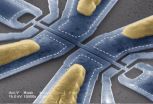(Press-News.org) People who carry a "G" instead of an "A" at a specific spot in the sequence of their genetic code have roughly a six-fold higher risk of developing certain types of brain tumors, according to a study by researchers at the University of California, San Francisco and Mayo Clinic.
The study was jointly led by geneticists Margaret Wrensch, PhD, and John Wiencke, PhD, professors in the Department of Neurological Surgery at UCSF, and Robert Jenkins, MD, PhD, professor of Laboratory Medicine in the Department of Laboratory Medicine and Pathology and the Division of Laboratory Genetics at the Mayo Clinic. The findings, published on August 26, 2012 in the journal Nature Genetics, could help researchers identify people at risk of developing certain subtypes of gliomas, which account for about 4,600 of the 23,000 brain cancers newly diagnosed annually in the US. This information could lead to better surveillance, diagnosis and treatment.
Based on their findings, the scientists already are starting to think about clinical tests that could tell patients with abnormal brain scans what kind of tumor they have, by simply testing their blood.
Researchers still need to understand how the specific DNA change actually causes the tumors, said Wrensch, since "this is among the first examples that a change in a non-coding portion of DNA can be so strongly associated with cancer risk."
The study began a few years ago when researchers started hunting for regions of the genome that might be associated with glioma development. They observed that a portion of chromosome 8 contained single nucleotide polymorphisms, or "SNPs," that were associated with brain tumors. Then, Wrensch, Wiencke, Jenkins and their colleagues used a combination of sophisticated genomic techniques to search for the SNP that was causing brain tumors to form.
They honed in on seven candidates, including the SNP called rs55705857, which confers a relative risk for glioma approaching that seen with changes in BRCA1 for breast cancer.
Interestingly, this region was only found through the most laborious method used by the researchers – next generation sequencing – suggesting that experimental and mathematical shortcuts may miss such rare, highly potent gene variants, the authors say.
Wrensch and Jenkins found that having the "G," or guanine, version of this SNP – rather than the more common "A" adenine version – was strongly associated with slower growing gliomas.
"Understanding how this variant causes people to get these less aggressive, but still lethal, tumors will be extremely important," Wrensch said. "It may eventually lead to methods to reverse the course of these tumors or possibly to prevent their formation."
As part of their work, the researchers compared the sequence of the gene variant throughout mammalian evolution and found that it has been conserved as far back as the platypus. Computer modeling indicated that the region may be a microRNA, a special kind of nucleic acid that controls the activity of genetic messages within cells. The modeling places the SNP within the functional part of the microRNA, suggesting that a change in genetic code from an "A" to a "G" could have significant consequences. The research team is investigating whether the microRNA actually exists, and what its functional implications might be.
"The altered microRNA might target tumor suppressor genes, it might activate a cancer gene, it might be involved in regulating the stability of the genome, or there might be something else going on altogether," Jenkins said. "One of the big challenges of the current genomic era is to assign functions to all these new gene variants."
INFORMATION:
Study funding at UCSF, was supported by the National Institutes of Health, the National Brain Tumor Foundation, the UCSF Lewis Chair in Brain Tumor Research, the Robert Magnin Newman Endowment in Neuro-oncology, and by donations from families and friends of John Berardi, Helen Glaser, Elvera Olsen, Raymond E. Cooper and William Martinusen.
Study funding at Mayo Clinic was supported by the National Institutes of Health, National Institute of Neurological Disorders and Stroke , the Bernie and Edith Waterman Foundation and the Ting Tsung and Wei Fong Chao Family Foundation. Jenkins is the Ting Tsung and Wei Fong Chao Professor of Individualized Medicine Research at Mayo Clinic.
For more information about gliomas and their treatment see http://neurosurgery.ucsf.edu/index.php/brain_tumor_center.html, http://neurosurgery.ucsf.edu/index.php/research_BTRC.html, or http://www.mayoclinic.org/glioma/.
UCSF is a leading university dedicated to promoting health worldwide through advanced biomedical research, graduate-level education in the life sciences and health professions, and excellence in patient care.
Follow UCSF
UCSF.edu | Facebook.com/ucsf | Twitter.com/ucsf | YouTube.com/ucsf
UCSF, Mayo team discovers genomic variant that increases risk of some brain tumors
2012-08-27
ELSE PRESS RELEASES FROM THIS DATE:
New wave of technologies possible after ground-breaking analysis tool developed
2012-08-27
A revolutionary tool created by scientists at the University of Sheffield has enabled researchers to analyse nanometer-sized devices without destroying them for the first time, opening the door to a new wave of technologies.
The nuclear magnetic resonance apparatus – developed by the University's Department of Physics and Astronomy – will allow for further developments and new applications for nanotechnology which is increasingly used in harvesting solar energy, computing, communication developments and also in the medical field.
Scientists can now analyse nanostructures ...
A lesson in sleep learning
2012-08-27
Is sleep learning possible? A new Weizmann Institute study appearing today in Nature Neuroscience has found that if certain odors are presented after tones during sleep, people will start sniffing when they hear the tones alone – even when no odor is present – both during sleep and, later, when awake. In other words, people can learn new information while they sleep, and this can unconsciously modify their waking behavior.
Sleep-learning experiments are notoriously difficult to conduct. For one thing, one must be sure that the subjects are actually asleep and stay that ...
Weighing molecules 1 at a time
2012-08-27
PASADENA, Calif.—A team led by scientists at the California Institute of Technology (Caltech) have made the first-ever mechanical device that can measure the mass of individual molecules one at a time.
This new technology, the researchers say, will eventually help doctors diagnose diseases, enable biologists to study viruses and probe the molecular machinery of cells, and even allow scientists to better measure nanoparticles and air pollution.
The team includes researchers from the Kavli Nanoscience Institute at Caltech and Commissariat à l'Energie Atomique et aux ...
Controlling gene expression: How chromatin remodelers block a histone pass
2012-08-27
KANSAS CITY, MO—Two opposing teams battle it out to regulate gene expression on the DNA playing field. One, the activators, keeps DNA open to enzymes that transcribe DNA into RNA. Their repressor opponents antagonize that effort by twisting DNA into an inaccessible coil around histone proteins, an amalgam called chromatin, effectively blocking access to DNA by enzymes that elongate an RNA strand.
Both teams maneuver by chemically modifying histones—the activators by decorating histones with acetyl groups—let's call them green flags—causing them to loosen their grip on ...
Compound discovered that boosts effect of vaccines against HIV and flu
2012-08-27
Oxford University scientists have discovered a compound that greatly boosts the effect of vaccines against viruses like flu, HIV and herpes in mice.
An 'adjuvant' is a substance added to a vaccine to enhance the immune response and offer better protection against infection.
The Oxford University team, along with Swedish and US colleagues, have shown that a type of polymer called polyethyleneimine (PEI) is a potent adjuvant for test vaccines against HIV, flu and herpes when given in mice.
The researchers were part-funded by the UK Medical Research Council and report ...
Merging the biological and the electronic
2012-08-27
Harvard scientists have, for the first, time created a type of "cyborg" tissue by embedding a three-dimensional network of functional, bio-compatible nanoscale wires into engineered human tissues.
As described in a paper published August 26 in Nature Materials, a multi-institutional research team led by Charles M. Lieber, the Mark Hyman, Jr. Professor of Chemistry at Harvard and Daniel Kohane, a Harvard Medical School professor in the Department of Anesthesia at Children's Hospital Boston developed a system for creating nanoscale "scaffolds" which could be seeded with ...
Manipulating the microbiome could help manage weight
2012-08-27
Vaccines and antibiotics may someday join caloric restriction or bariatric surgery as a way to regulate weight gain, according to a new study focused on the interactions between diet, the bacteria that live in the bowel, and the immune system.
Bacteria in the intestine play a crucial role in digestion. They provide enzymes necessary for the uptake of many nutrients, synthesize certain vitamins and boost absorption of energy from food. Fifty years ago, farmers learned that by tweaking the microbial mix in their livestock with low-dose oral antibiotics, they could accelerate ...
Scientists identify new gene that influences survival in ALS
2012-08-27
WORCESTER, MA — A team of scientists, including faculty at the University of Massachusetts Medical School (UMMS), have discovered a gene that influences survival time in amyotrophic lateral sclerosis (ALS, also known as Lou Gehrig's disease). The study, published today in Nature Medicine, describes how the loss of activity of a receptor called EphA4 substantially extends the lifespan of people with the disease. When coupled with a UMMS study published last month in Nature identifying a new ALS gene (profilin-1) that also works in conjunction with EphA4, these findings point ...
Researchers develop method to grow artificial tissues with embedded nanoscale sensors
2012-08-27
Boston, Mass.—A multi-institutional research team has developed a method for embedding networks of biocompatible nanoscale wires within engineered tissues. These networks—which mark the first time that electronics and tissue have been truly merged in 3D—allow direct tissue sensing and potentially stimulation, a potential boon for development of engineered tissues that incorporate capabilities for monitoring and stimulation, and of devices for screening new drugs.
The researcher team—led by Daniel Kohane, MD, PhD, in the Department of Anesthesia at Boston Children's Hospital; ...
Pitt: Targeted oxidation-blocker prevents secondary damage after traumatic brain injury
2012-08-27
PITTSBURGH, Aug. 26, 2012 – Treatment with an agent that blocks the oxidation of an important component of the mitochondrial membrane prevented the secondary damage of severe traumatic brain injury and preserved function that would otherwise have been impaired, according to a research team from the University of Pittsburgh School of Medicine, Graduate School of Public Health and Department of Chemistry in a report published online today in Nature Neuroscience.
Annually, an estimated 1.7 million Americans sustain a traumatic brain injury (TBI) due to traffic accidents, ...


